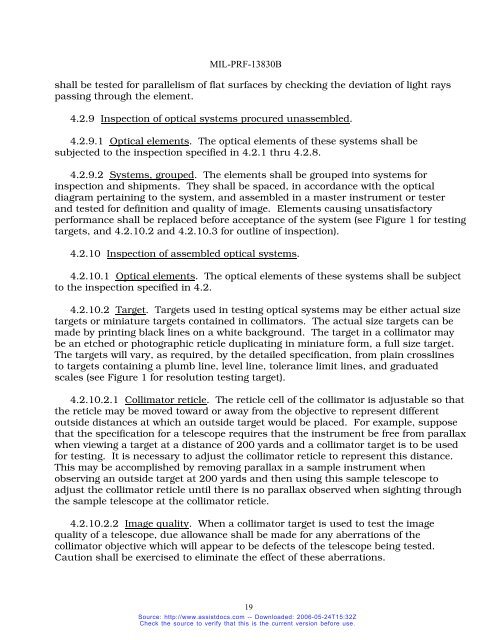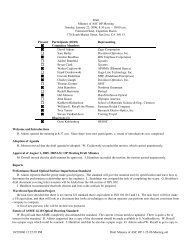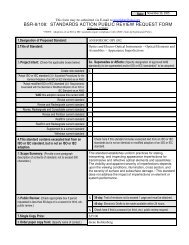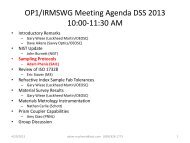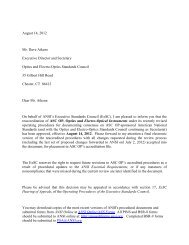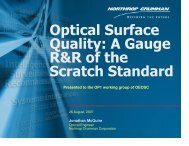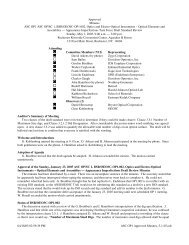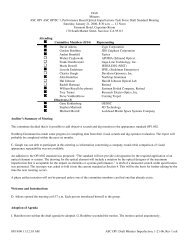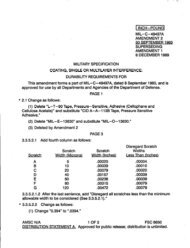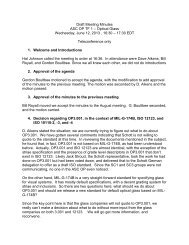INCH-POUND MIL-PRF-13830B 9 January 1997 SUPERSEDING ...
INCH-POUND MIL-PRF-13830B 9 January 1997 SUPERSEDING ...
INCH-POUND MIL-PRF-13830B 9 January 1997 SUPERSEDING ...
Create successful ePaper yourself
Turn your PDF publications into a flip-book with our unique Google optimized e-Paper software.
<strong>MIL</strong>-<strong>PRF</strong>-<strong>13830B</strong><br />
shall be tested for parallelism of flat surfaces by checking the deviation of light rays<br />
passing through the element.<br />
4.2.9 Inspection of optical systems procured unassembled.<br />
4.2.9.1 Optical elements. The optical elements of these systems shall be<br />
subjected to the inspection specified in 4.2.1 thru 4.2.8.<br />
4.2.9.2 Systems, grouped. The elements shall be grouped into systems for<br />
inspection and shipments. They shall be spaced, in accordance with the optical<br />
diagram pertaining to the system, and assembled in a master instrument or tester<br />
and tested for definition and quality of image. Elements causing unsatisfactory<br />
performance shall be replaced before acceptance of the system (see Figure 1 for testing<br />
targets, and 4.2.10.2 and 4.2.10.3 for outline of inspection).<br />
4.2.10 Inspection of assembled optical systems.<br />
4.2.10.1 Optical elements. The optical elements of these systems shall be subject<br />
to the inspection specified in 4.2.<br />
4.2.10.2 Target. Targets used in testing optical systems may be either actual size<br />
targets or miniature targets contained in collimators. The actual size targets can be<br />
made by printing black lines on a white background. The target in a collimator may<br />
be an etched or photographic reticle duplicating in miniature form, a full size target.<br />
The targets will vary, as required, by the detailed specification, from plain crosslines<br />
to targets containing a plumb line, level line, tolerance limit lines, and graduated<br />
scales (see Figure 1 for resolution testing target).<br />
4.2.10.2.1 Collimator reticle. The reticle cell of the collimator is adjustable so that<br />
the reticle may be moved toward or away from the objective to represent different<br />
outside distances at which an outside target would be placed. For example, suppose<br />
that the specification for a telescope requires that the instrument be free from parallax<br />
when viewing a target at a distance of 200 yards and a collimator target is to be used<br />
for testing. It is necessary to adjust the collimator reticle to represent this distance.<br />
This may be accomplished by removing parallax in a sample instrument when<br />
observing an outside target at 200 yards and then using this sample telescope to<br />
adjust the collimator reticle until there is no parallax observed when sighting through<br />
the sample telescope at the collimator reticle.<br />
4.2.10.2.2 Image quality. When a collimator target is used to test the image<br />
quality of a telescope, due allowance shall be made for any aberrations of the<br />
collimator objective which will appear to be defects of the telescope being tested.<br />
Caution shall be exercised to eliminate the effect of these aberrations.<br />
19<br />
Source: http://www.assistdocs.com -- Downloaded: 2006-05-24T15:32Z<br />
Check the source to verify that this is the current version before use.


